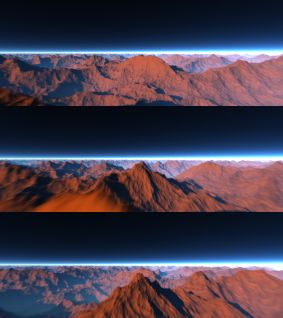Photo-realistic Rendering of
Synthetic Procedural Planets on a Grid
Manuel N. Gamito
Department of Computer Science
The University of Sheffield
The realistic rendering of complex procedural terrain over the entire
surface of a planet is a CPU intensive task that can benefit from a
grid implementation. This grid implementation is particularly simple if a
ray tracing algorithm is chosen to perform the rendering. This is
because in ray tracing each image pixel is rendered independently of all
the others by tracing a viewing ray through the pixel and finding its
intersection with the scene. It becomes, therefore, a straightforward
task to split an image into smaller regions and to schedule the regions
across the available processors.
A grid implementation of a ray tracer is here presented for rendering
computer animated image sequences of a virtual camera travelling over a
synthetic procedural landscape. This work was developed as part of the
CIC6004 course in Grid Computing, offered by the Corporate Information
& Computing Services Centre of the University of Sheffield. At the
same time, the course work was intended to provide a valuable tool for
the research developed by the author as part of his PhD work. For this
reason, the current grid rendering tool will continue to be supported
and developed in the future.
The grid rendering tool implements distribution at two levels. At the
higher level, individual images are distributed across the available
grid nodes by a meta-scheduler that runs remotely from a desktop PC with
secure access to the grid. At the lower level, each image, after being
assigned to some grid node, is split into smaller regions that are
subsequently distributed across the processors of that node.
Distribution of image regions across a node is handled by the local job
scheduler for the node. A complete description of the grid tool can be
found in the technical report CS-07-01 for the Department of Computer
Science that is available below. This report also includes in appendix
the source code for the meta-scheduler, which was written with Python
script.
PDF format (298K) (CS0701.pdf)
The grid rendering tool
was tested on the White Rose Grid and used three of its nodes: the
Iceberg node at Sheffield and the Everest and Snowdon nodes at Leeds.
The image on the right shows an example of a synthetic procedural
landscape that can be rendered with this tool. By clicking on the image
it is possible to download the original high resolution image that was
rendered on the Iceberg node.
|

|

|
The image on the left shows three frames
of a 500 frame computer animation of a virtual camera travelling over a
synthetic planet at a constant altitude of 25 metres and with a constant
speed of 60 km/h. Played at the rate of 25 frames per second, the 500
frame animation corresponds to 20 seconds of playback time. At the speed
the camera is travelling, the animation would need to have a duration
of almost a month of continuous playback time for a complete
circumnavigation of the planet to be achieved. In this impractical
scenario, the first and last frames of the animation would be equal and
the animation could be looped indefinitely.
The complete animation took five days to
complete on the White Rose Grid. It can be downloaded as a Quicktime
movie file from the address below. A free Quicktime player must be
installed first and is available at the address http://www.apple.com/quicktime.
Quicktime MOV format (32.4M) (flyby.mov)
|

